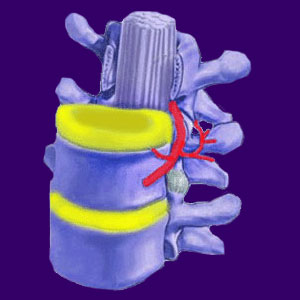
Intervertebral discs are also called spinal discs or simply discs (sometimes spelled disks). These spinal discs act as shock absorbers and cushions in between the individual vertebrae. There are 23 discs in the normal human spine. When added together, the spinal discs make up about one quarter of the spine’s total length.
Human spinal discs can not and will not ever slip. The concept of a slipped disc is a greatly misunderstood phenomenon. Discs never slip. They herniate. The spinal discs are bonded to the vertebral bones above and below and it is only the soft inner core which might bulge or rupture out of the normally symmetrical disc structure.
This educational essay helps patients to better understand the structure and function of the spinal discs.
Spinal Disc Structure
Spinal discs are composed of a tough fibrous outer wall, called the annulus fibrosus, and a softer pliable inner core, known as the nucleus pulposus. Discs are mostly composed of water, collagen and proteoglycans. The outer walls are thick and multilayered to resist wear and tear. The inner core is moist and more flexible.
Discs have no blood supply and receive nutrients through cartilaginous end plates attaching the discs to the surrounding vertebrae.
Discs have a variable percentage of water in them, depending on the time of day and activity level. As we age, the discs naturally tend to dehydrate and shrink. This is sometimes called degenerative disc disease, but it is rarely symptomatic by itself. Disc shrinkage is simply a normal part of aging.
Intervertebral Discs and Back Pain
Discs are one of the great scapegoats in the medical interpretation of dorsalgia. They are blamed for many symptomatic conditions, but are rarely the cause of chronic back pain.
Discs contain no internal neurological tissue and can not feel any pain by themselves. This is not a commonly known fact. Most people with back or neck pain caused by a herniated disc think that the herniation itself is painful. This is a myth. Spinal discs are little more than organic jelly rings enclosed in tough outer casings and can only cause pain if they somehow influence a neurological structure, such as through forceful compression or chemical irritation.
Of all back and neck pain treatments, those directed at theorized disc pathologies fare the worst statistically. Out of all the invasive procedures used to correct spinal abnormalities, disc surgeries are by far the most common and also generate terrible results for lasting pain relief.
The spinal disc has the distinction of being suspected of causing pain through more possible processes than any other single abnormal spinal structure or process. This is ironic, considering the well known fact that disc pathologies have no actual correlation to the incidence of ongoing back or neck pain.




